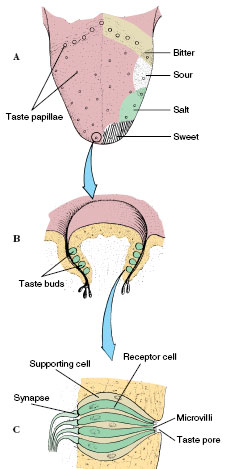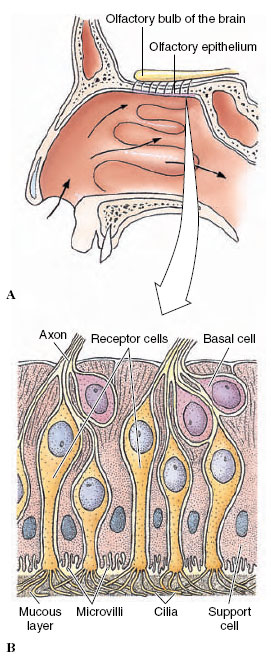Chemoreception
 |
| Figure 35-18 Pheromone-producing glands of an ant. |
Chemoreception is the oldest and most universal sense in the animal kingdom. It probably guides behavior of animals more than any other sense. Unicellular forms use contact chemical receptors to locate food and adequately oxygenated water and to avoid harmful substances. These receptors elicit an orientation behavior, called chemotaxis, toward or away from the chemical source. Most metazoans have specialized distance chemical receptors, which are often developed to a remarkable degree of sensitivity. Distance chemoreception, usually called smell or olfaction, guides feeding behavior, location and selection of sexual mates, territorial and trail marking, and alarm reactions of numerous animals.
 |
| Figure 35-19 Taste receptors. A, Surface of human tongue showing regions of maximum sensitivity to the four primary taste sensations. B, Position of taste buds on a taste papilla. C, Structure of a taste bud. |
Social insects and many other animals, including mammals, produce species-specific compounds, called pheromones, that constitute a highly developed chemical language. Pheromones are a diverse group of organic compounds that an animal releases to affect the physiology or behavior of another individual of the same species. Ants, for example, are walking batteries of glands (Figure 35-18) that produce numerous chemical signals. These include releaser pheromones, such as alarm and trail pheromones, and primer pheromones, which alter endocrine and reproductive systems of different castes in the colony. Insects bear a variety of chemoreceptors on the surface of the body for sensing specific pheromones, as well as other, nonspecific odors.
In all vertebrates and in insects, the senses of taste and smell are clearly distinguishable. Although there are similarities between taste and smell receptors, in general taste is more restricted in response and is less sensitive than smell. Central nervous system centers for taste and smell are located in different parts of the brain.
In vertebrates, taste receptors are found in the mouth cavity and especially on the tongue (Figure 35-19), where they provide a means for judging foods before they are swallowed. A taste bud consists of a cluster of receptor cells surrounded by supporting cells; it is provided with a small external pore through which the slender tips of the sensory cells project. Chemicals being tasted apparently combine with specific receptor sites on microvilli of the receptor cells. Although the mechanisms are different for each basic taste sensation, receptor cells are depolarized by the specific chemical to which the cell is sensitive and action potentials are generated. These impulses are transmitted across chemical synapses and travel along sensory neurons to specific brains regions. Because receptor cells are subject to wear and tear by abrasive foods, taste buds have a short life (5 to 10 days in mammals) and are continually being replaced.
The four basic taste sensations possessed by humans—sour, salty, bitter, and sweet—are each attributable to a different kind of taste bud. The tastes for salty and sweet are found mainly on the tip, bitter at the base, and sour along the sides of the tongue. Of these, the bitter taste is by far the most sensitive, because it provides early warning against potentially dangerous substances, many of which are bitter.
 |
| Figure 35-20 Human olfactory epithelium. A, The epithelium is a patch of tissue positioned in the roof of the nasal cavity. B, It is composed of supporting cells, basal cells , and olfactory receptor cells with cilia protruding from their free ends. |
Smell is more complex than taste, and until very recently odor research has lagged behind other areas of sensory physiology. Although the olfactory sense is a primal sense for many animals, used for identification of food, sexual mates, and predators, olfaction is most highly developed in mammals. Even humans, although a species not celebrated for detecting smells, can discriminate perhaps 20,000 different odors. A human nose can detect 1/25 of one-millionth of 1 mg of mercaptan, the odoriferous substance of skunks. Even so, our olfactory abilities compare poorly with those of other mammals that rely on olfaction for survival. A dog explores new surroundings with its nose much as we do with our eyes. A dog’s nose is justifiably renowned; with some odorous sources a dog’s nose is at least a million times more sensitive than ours. Dogs are assisted in their proficiency by having a nose located close to the ground where odors from passing creatures tend to linger.
Olfactory endings are located in a special epithelium covered by a thin film of mucus, positioned deep in the nasal cavity (Figure 35-20). Within the epithelium lie millions of olfactory neurons, each with several hairlike cilia protruding from the free end. Odor molecules entering the nose bind to receptor proteins located in the cilia; this binding generates an electrical signal that travels along axons to the olfactory bulb of the brain. From here odor information is sent to the olfactory cortex where odors are analyzed. Odor information is then projected to higher brain centers where they affect emotions, thoughts, and behavior.
Recently, using techniques of gene cloning and molecular hybridization), researchers discovered a large family of genes that appears to code for odor reception in mammals (including humans). Each of the 500 to 1000 genes discovered encodes a separate type of odor receptor. Since mammals can detect at least 20,000 different odors, each receptor must respond to several odor molecules, and each odor molecule must bind with several types of receptors, each of which responds to a part of the molecule’s structure. Brain mapping techniques have shown that each olfactory neuron projects to a characteristic location on the olfactory bulb, providing a two-dimensional map that identifies which receptors have been activited in the nose. In addition, olfactory neurons expressing the same odor receptor gene converge to a fixed olfactory bulb region, which might provide an explanation for the extremely high sensitivity of smell. Projected to the brain, odor information is recognized as a unique scent.
Because flavor of food depends on odors reaching the olfactory epithelium through the throat passage, taste and smell are easily confused. All “tastes” other than the four basic ones (sweet, sour, bitter, salty) result from flavor molecules reaching the olfactory epithelium in this manner. Food loses its appeal during a common cold because a stuffy nose blocks odors rising from the mouth.




